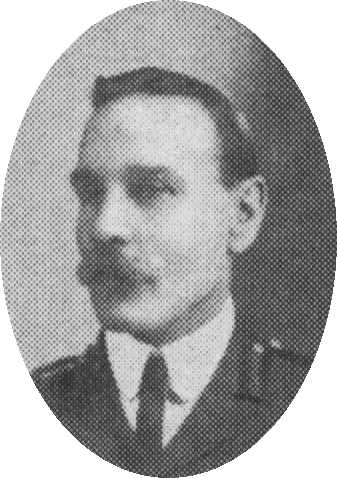


John Kealty Forsyth was born in Brisbane on 8 February 1867, the son of a builder. He was educated at Fortitude Valley State and the Normal School, Brisbane and became a clerk in a sawmill and later in a solicitor's office.
Forsyth enlisted in the Queensland Mounted Rifles as a trooper in November 1885. He served in all NCO ranks before being commissioned a second lieutenant in the Queensland Mounted Infantry on 18 July 1892. He was promoted to lieutenant on 4 November 1892 and captain on 22 September 1896. He joined the Queensland Permanent Forces at a staff lieutenant on 1 August 1897, and was promoted to captain on 1 February 1901. Forsyth served as adjutant of the 4th Queensland Mounted Infantry from 1 March 1901 to 27 February 1902, of the 2nd Queensland Mounted Infantry and 4th Infantry Regiment from 28 February 1902 to 30 June 1902, and of the 2nd Queensland Mounted Infantry again from 1 July 1902 to 12 November 1905.
Forsyth moved to Melbourne, where he served in the usual round of staff appointments that was typical of the regular officers of the day. He became secretary to the Inspector General, Major General H. Finn, from 13 November 1905 to 1 October 1906. He joined the Victorian Instructional Staff on 1 February 1907 and was promoted to major on 28 May 1908. In 1909-1910 he was posted to India on exchange duty with the British Indian Army as brigade major of the Amballa Cavalry Brigade. Returning to Melbourne, he was Deputy Assistant Adjutant General (DAAG) for Instruction from 1 to 31 December 1910. Forsyth was a GSO2 at Army Headquarters from 1 November 1911 to 30 June 1912, became Director of Equipment on 1 July 1907, and was promoted to lieutenant colonel on 1 March 1914. On 1 August 1914, he became Quartermaster General and a member of the Military Board.
Just two weeks later, on 15 August 1914, Forsyth joined the AIF as a temporary colonel. Appointed to command the 1st Division's mounted regiment, the 4th Light Horse Regiment, he also took on responsibility for raising the 1st Light Horse Brigade, whose commander designate, Colonel, H. G. Chauvel, was still on duty in the United Kingdom. Forsyth embarked with the brigade on 21 October 1914 and handed over command to Chauvel on the latter's arrival in Egypt in November 1914. Forsyth then concentrated on training his own regiment, who referred to him as "Dad".
In May 1915, the light horse were ordered to Gallipoli dismounted to reinforce the infantry. Forsyth arrived at Anzac on 5 May 1915. On 19 May 1915, he became the Assistant Adjutant and Quartermaster General (AA & QMG) of the 1st Division. From 30 May to 8 June he was acting commander of the 2nd Brigade in the absence of Colonel J. W. McCay, who had been wounded at Krithia, along with most of the brigade's officers. When McCay was evacuated with a broken leg, Forsyth became commander of the 2nd Brigade on 26 July 1915 and was promoted to colonel and temporary brigadier general. He remained at Anzac with his brigade, fighting another battle at the German Officers' Trench in August, until it was evacuated to Mudros on 10 December 1915.
The 2nd Brigade returned to Egypt in January 1916, and moved to Serapeum, where it guarded the Suez Canal. On 27 March 1916, it sailed for France. The brigade spent a time in the relatively quiet Armentieres sector before it was committed on the Somme at Pozieres in July. There it was subjected to intense artillery bombardments. Forsyth suffered a breakdown in his health and was evacuated to England. When he was discharged from the hospital, he became commander of 'B' Training Group at Rollestone, England. Ill health forced his return to Australia in December 1916. For his services on the Western Front he was mentioned in dispatches and was appointed a Companion of St Michael and St George (CMG) on 1 January 1917.
Forsyth became Commandant of the 4th Military District (South Australia) on 16 February 1917 and was promoted to brevet colonel on 24 September 1917. On 2 July 1918, he once again became Quartermaster General and a member of the Military Board. He was promoted to temporary major general in January 1921 but had to relinquish the rank when he was placed on the unattached list in 1922. He retired with the rank of major general on 9 February 1925.
In 1928, Forsyth was selected as a Nationalist candidate for the Senate. While campaigning in Sea Lake, Victoria, he came down with influenza and died nine days later on 12 November 1928. He was buried at Boroondara Cemetery, Kew, with full military honours.
Sources: Australian Dictionary of Biography, 1899-1939, Vol 7, pp. 555-556; AWM 183/20; Bean, C. E. W., The Official History of Australia in the War of 1914-1918. Volume II: The Story of Anzac, p. 869
Page created by Ross
Mallett
ross@metva.com.au
Last update 25 July 2002